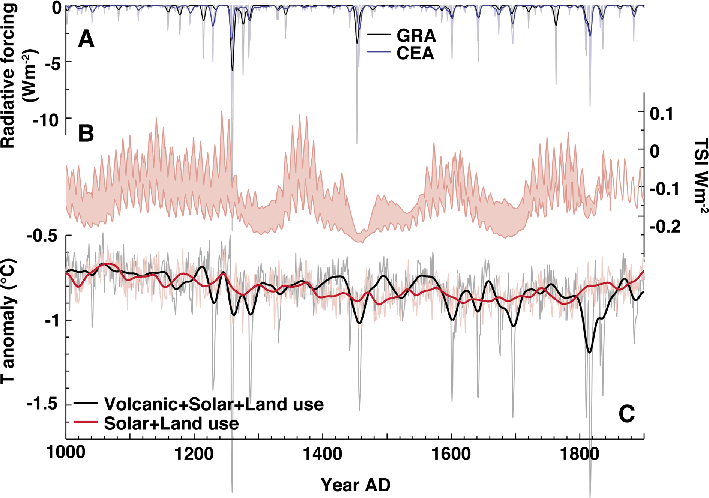- Home
- Publications
- PAGES Magazine
- Editorial: Volcanic Eruptions and Climate
Editorial: Volcanic eruptions and climate
Allegra N. LeGrande and Kevin J. Anchukaitis
Past Global Changes Magazine
23(2)
46-47
2015
Allegra N. LeGrande1 and Kevin J. Anchukaitis2
Volcanic eruptions represent some of the most climatically important and societally disruptive short-term events in human history. Large eruptions inject ash, dust, sulfurous gases (e.g. SO2, H2S), halogens (e.g. HCl and HBr), and water vapor into the Earth's atmosphere. Sulfurous emissions principally interact with the climate by converting into sulfate aerosols that reduce incoming solar radiation, warming the stratosphere and altering ozone creation, reducing global mean surface temperature, and suppressing the hydrological cycle. In this issue, we focus on the history, processes, and consequences of these large eruptions that inject enough material into the stratosphere to significantly affect the climate system. In terms of the changes wrought on the energy balance of the Earth System, these transient events can temporarily have a radiative forcing magnitude larger than the range of solar, greenhouse gas, and land use variability over the last millennium. In simulations (Fig. 1) as well as modern and paleoclimate observations, volcanic eruptions cause large inter-annual to decadal-scale changes in climate. Active debates persist concerning their role in longer-term (multi-decadal to centennial) modification of the Earth System, however.
Societal systems are affected as well, and agriculture and infrastructure can be profoundly disturbed by these severe short-term geological and climate events, even at locations quite distant from the eruptions themselves. For instance, Puma et al. (p.66) demonstrate an association between volcanic eruptions with some of the worst famines in human history.
Despite their importance for both climate and natural hazards, there remain substantial gaps in our knowledge of the physics, magnitude, timing, and impacts of large volcanic eruptions. Robock (p.68) highlights several persistent climatic mysteries related to volcanoes and uncertainties in our understanding of processes linking eruptions to both short- and long-term changes in the climate system.
Historical accounts, geological evidence, and ice cores provide evidence of eruptions in the past that were much larger than those documented and observed since the 19th century, and volcanoes represent the most important forcing in last millennium transient climate simulations, at least until the dawn of the industrial era (Jungclaus et al. 2010). Various groups (Crowley and Unterman 2013; Gao et al. 2008; Sigl et al. 2015) have taken the initiative of estimating volcanic forcing from ice core records using the coherence of sulfate horizons in ice core records to infer volcanic eruptions. Lower (tropical) latitude and higher magnitude eruptions were inferred when there was greater coherence and higher sulfate concentrations across sites. Through a clever bit of historical work, Stothers (1984) was able to calculate the volcanic aerosol optical depth (AOD) after the 1815 Tambora eruption by digging through newspaper archives and finding mention of visible sunspots at a certain day and time, which indicated a certain minimum aerosol optical depth. Paired with the sulfate horizon observed in ice core records, it is possible to develop a conversion factor between sulfate horizon and AOD. Unsurprisingly, this process can be highly uncertain. And indeed, estimates of both the timing and magnitude of past major volcanic eruptions differ, in some cases substantially, between different ice-core derived calculations of volcanic forcing (Fig. 1; Schmidt et al. 2010). Sigl et al. (p.48) detail their latest work to establish an improved chronology for volcanic eruptions during the Common Era, in particular an improved 1st millennium record and suggest a reduced magnitude for some of the largest last millennium eruptions, including the 1250s Samalas eruption.
Early work following the Mt. Pinatubo 1991 eruption showed that global mean annual surface temperature decreased by ~0.5°C (Hansen et al. 1996). This and subsequent research on Pinatubo has been important not only because of the insights provided about the response and sensitivity of the climate system to radiative perturbations, but because knowledge of this particular eruption forms a key part of how we model the Earth System’s response to other eruptions in the planet's history. Translating (parameterizing) the observed volcanic perturbation into forcing fields for global climate models (GCMs) has been accomplished, in a variety of ways with varying complexity, from exceptionally simple top-of-the-atmosphere shortwave forcing, to an intermediate complexity estimate of change in the AOD of the atmosphere, and the effective radius of the volcanic aerosol particles (Reff) that have specific radiative properties to more sophisticated aerosol microphysical representation of SO2 injection and sulfate aerosol development; with the most sophisticated treatments coming into use for the upcoming Coupled Model Intercomparison Project (CMIP6). To estimate Reff for eruptions besides Pinatubo, many modeling groups follow the technique used by Sato et al. (1993), where satellite information about the co-evolution of AOD and Reff by latitude after Pinatubo are generalized to prescribe Reff for other eruptions given AOD. In a sense, this means that each volcanic simulation reflects a scaled version of the 1991 Mt. Pinatubo event.
Lacis describes in this issue (p.50) how particle size, not just mass or optical depth, is important for determining the radiative properties of aerosols. These particles not only scatter incoming shortwave radiation (as expected from reduced surface temperatures following volcanic eruptions), but also absorb and re-emit some energy, giving a positive thermal forcing, and warming the stratosphere. Mann G. and others show in detail (p.52) the importance of getting this size distribution, Reff, correct, and the shortcomings of previous efforts in this regard.
Timmreck et al. (2009), amongst others, have demonstrated that our representation of volcanoes is likely oversimplified, which has important consequences for how we simulate the climate impacts of past volcanic eruptions. By implication, modeling estimates of possible geoengineering solutions using solar radiation management are likewise incomplete. Each climate modeling group makes its own decisions about how to apply and simulate volcanic eruptions – past, present, and future; for example, which atmospheric layers to specify, how many latitude bands, and how to define and apply estimates of AOD and Reff. There is a substantial need for greater coordination and communication regarding these modeling efforts. CMIP6 will include a coordinated project focusing on volcanic eruptions (“VolMIP”), which Zanchettin and others describe in this issue (p.54).
The 1991 Mt. Pinatubo eruption was the largest eruption of the 20th century, and even the simplest of parameterizations in GCMs provides a reasonable approximation of this event that the model was designed to produce. However, to provide out-of-sample validation for models, tree rings and other paleoclimate proxies can be used to estimate past temperature and precipitation changes following large eruptions. For instance, Churakova et al. (p.64) show multiple lines of proxy evidence for the large 6th century eruption in Siberian tree-ring chronologies.
However, for large events (greater than the 1991 Mt. Pinatubo event), there are in some cases stark differences between the simulated GCM and reconstructed climate response (Anchukaitis et al. 2012; Mann M.E. et al. 2012; Zanchettin, this issue). For instance, climate models simulate extremely large (>1°C) cold excursions following the mid-to-late-13th century volcanic eruptions, including the 1250s eruption of Samalas (which the CMIP5 forcing reconstructions estimate at roughly 10x the magnitude of the 1991 Mt. Pinatubo event; Fig. 1). The proxy reconstructed temperature response is generally smaller and less spatially coherent than the global cooling pattern (global cooling 50-200% larger than Pinatubo) simulated by GCMs. Identifying the source of this mismatch is of paramount importance in understanding the impacts of large eruptive events and building climate models capable of reproducing them. Timmreck et al. (2009) and English et al. (2013) have explored possible modeling reasons for this, and Sigl et al. (p.48) suggest a new, reduced magnitude for the 1250s eruption. St. George and Anchukaitis (p.60) explore this potential mismatch from the proxy point of view of the large 19th century eruption of Tambora. Stine et al. (p.62) investigate the possible role of changing light conditions in influencing the growth response of trees after certain volcanic eruptions, which could modulate the inferred magnitude of post-event cooling.
Volcanic eruptions affect the hydrological cycle as well as temperatures. In this issue, Iles et al. (p.56) show that global rainfall decreases by up to 0.04-0.05 mm per day following large eruptions. Focusing on the Asian monsoon region, Gao (p.58) illustrate the reductions in monsoon rains in the years following an eruption may be an order of magnitude larger than the global average.
The papers in this issue collectively represent not just a summary of the current science, but also more importantly a series of implicit and explicit challenges to the modeling, observation, and paleoclimate communities. Robock (p.68) directly sets out a series of tantalizing questions, and it is clear that a consilience of simulated and reconstructed temperature response has not yet been achieved. Likely explanations for these differences lie at least in part on our representation of the processes governing the climate consequence of eruptions in state-of-the-art GCMs, including aerosol processes, as well as precise knowledge of the timing and magnitude of past events. Paleoclimate proxies are a filter through which we peer into the past, and thus the biological, chemical, and physical mechanisms that give rise to these records need to be better understood. Addressing these myriad and extant uncertainties will require close coordination between those specializing in paleoclimate reconstruction, Earth System modeling, and present observations of the climate system: scientists with domain knowledge in aerosol and particulate behavior in the atmosphere, geologists and ice core specialists with knowledge of both atmospheric processes and geochronology, social scientists and engineers who understand the coupled human and natural systems impacted by eruptions, and climate modelers. Volcanic eruptions and their influence on coupled Earth systems cut across traditional disciplinary boundaries, and will continue to require collaboration and a high degree of international cooperation.
PAGES has recently organized the “Volcanic Impacts on Climate and Society” (VICS) working group. The principal aims of this group are to improve radiative forcing; understanding of volcanically induced climate variability; and understanding of societal impacts of volcanic eruptions. The group hopes to extend our current volcanic forcing datasets, largely limited to the last millennium back to the beginning of the Holocene. This work will facilitate model-to-data inter comparisons such as those of SSiRC (Stratospheric Sulfate and its Role in Climate), PMIP4 (Paleoclimate and Modeling Intercomparison Project, Phase 4), and VolMIP (Model Intercomparison Project on the Climatic Response to Volcanic Forcing). In addition to editors Allegra LeGrande and Kevin Anchukaitis, the PAGES VICS working group will be lead by Michael Sigl, Matthew Toohey and Francis Ludlow.
affiliations
1NASA Goddard Institute for Space Studies, New York, USA
2School of Geography and Development and Laboratory of Tree-Ring Research, University of Arizona, Tucson, USA
contact
Allegra N. LeGrande: allegra.n.legrande nasa.gov
nasa.gov
references
Anchukaitis KJ et al. (2012) Nature Geosci 5: 836-837
Crowley TJ, Unterman MB (2013) Earth Syst Sci Data 5: 187-197
English JM et al. (2013) J Geophys Res 118: 1880-1895
Gao C et al. (2008) J Geophys Res Atmos 113, doi: 10.1029/2008JD010239
Hansen J et al. (1996) NATO ASI Series 42: 233-272
Jungclaus JH et al. (2010) Clim Past 6: 723-737
Mann ME et al. (2012) Nature Geosci 5: 202-205
Pongratz et al. (2008) Global Biogeochem Cycles 22, doi:10.1029/2007gb003153
Sato M et al. (1993) J Geophys Res Atmos 98: 22987-22994
Schmidt GA et al. (2012) Geosci Model Dev 5: 185-191
Sigl M et al. (2015) Nature 523: 543-549
Steinhilber F et al. (2009) Geophys Res Lett 36, doi:10.1029/2009GL040142
Stothers RB (1984) Science 224: 1191-1198
Timmreck C et al. (2009) Geophys Res Letters 36, doi:10.1029/2009GL040083

